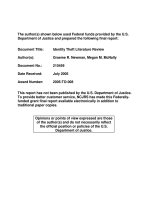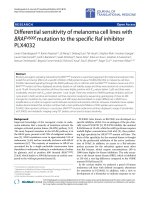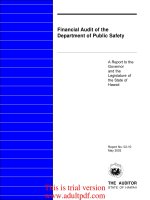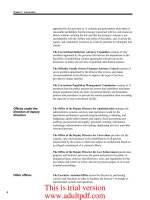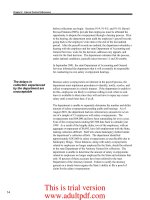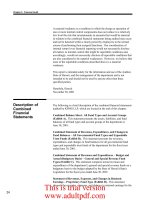APPLICATION WHAT-IF OF HAZOP AND SAFETY REVIEW AND TO THE PETROLEUM, PETROCHEMICAL CHEMICAL INDUSTRIES pot
Bạn đang xem bản rút gọn của tài liệu. Xem và tải ngay bản đầy đủ của tài liệu tại đây (7.68 MB, 136 trang )
APPLICATION OF HAZOP AND
WHAT-IF SAFETY REVIEW
TO THE PETROLEUM,
PETROCHEMICAL AND
CHEMICAL INDUSTRIES
Dennis P. Nolan, P.E.
I PI
n
NOYES PUBLICATIONS
Park Ridge, New Jersey, U.S.A.
Copyright 0 1994 by Dennis P. Nolan, P.E.
No part of this book may be reproduced or utilized in
any form or by any means, electronic or mechanical,
including photocopying, recording or by any informa-
tion storage and retrieval system, without permission
in writing from the Publisher.
Library of Congress Catalog Card Number: 94-4889
ISBN: O-8155-1353-4
Printed in the United States
Published in the United States of America by
Noyes Publications
Mill Road, Park Ridge, New Jersey 07656
10987654321
Library of Congress Cataloging-in-Publication Data
Nolan, Dennis P.
Application of HAZOP and What-If safety reviews to the petroleum,
petrochemical & chemical industries / by Dennis P. Nolan.
p. cm.
Includes bibliographical references and index.
ISBN O-8155-1353-4
1. Chemical engineering Safety measures. I. Title,
TPI49.N65 1994
660’.2804 dc20
94-4889
CIP
ABOUT THE AUTHOR
Dennis P. Nolan has had a long career devoted to risk
engineering, fire protection engineering, loss prevention
engineering, and systems safety engineering. He holds a Masters
degree in Systems Management from the Florida Institute of
Technology, and a Bachelor’s degree in Fire Protection Engineering
from the University of Maryland. He is a U.S. registered pro-
fessional engineer, in fire protection engineering in the state of
California.
He is currently associated with the Occidental Petroleum
Corporation as corporate-wide Risk Engineering Advisor, with
previous roles as Facilities Engineering Advisor and Senior Fire
Protection Engineer. He has also been associated with Lockheed,
Marathon Oil and Boeing in various risk and safety roles.
He has received a number of safety awards, and is a member
of a number of professional organizations.
. . .
111
PREFACE
This document is intended as a typical guideline and reference
book that may be applied at petroleum, petrochemical and chemical
facilities. It is suggested that this document is used as a practical
reference to prepare the safety review requirements for these and
related industries, and their process safety management systems.
This publication is intended to provide guidance to I-IAZOP
(Hazard and Operability) and What-If review teams associated
with the petroleum, petrochemical, and chemical industries. It
describes the nature, responsibilities, methods and documentation
required in the performance of such reviews. This ensures the
reviews are conducted in a timely, effective and professional
manner as may be prescribed by a company’s Process Safety
Management (PSM) Policy.
A completed review report can be used to demonstrate to
interested parties that a process hazard analysis has been
accomplished and all possible actions have been examined and/or
implemented to eliminate major hazards.
This document can also be referred to by review team
members, It will serve as a reminder of their duties and
responsibilities in the performance of the required reviews and
report development.
Notice
Reasonable care has been taken to assure that the books
content is authentic, timely and relevant to industry
today; however, no representation or warranty is made as
to its accuracy, completeness or reliability. Consequently,
the author and publisher shall have no responsibility or
liability to any person or organization for loss or damage
caused, or believed to be caused, directly or indirectly,
by this information. In publishing this book, the
publisher is not engaged in rendering legal advice or
other professional services. It is up to the reader to
investigate and assess his own situation. Should such
study disclose a need for legal or other professional
assistance the reader should seek and engage the services
of qualified professionals.
vi
CONTENTS
P. PURPOSE . . . . . . . a.“.* a as o e o e a e.0 0 o e o oo o. 1
2. SCOPE .s ~.* ~ ~ 3
3. OBJECTIVE AND DESCRIPTION OF HAZOP AND WHAT-IF REVIEWS e . . e 4
4. TEAM MEMBERS, QUALIFICATIONS AND RESPONSIBILITIES /I a o a a a o a a m 9
5. MANAGEMENT SUPPORT AND RESPONSIBILITIES . o . . . . . s . e e a n o e o . . 21
6. REVIEW APPLICATIONS FOR TYPICAL FACILITIES . . . . o . . a . e , o . e o o a 23
7. HAZOP AND WHAT-IF REVIEW PROCEDURES . . . . . . . . . . . . . o * e . . . . . 29
8. HAZOP AND WHAT-IF WORKSHEETS
53
9, REPORT PREPARATION AND DISTRIBUTION
59
80. HANDLING AND RESOLUTION OF RECOMMENDATIONS . . 1 . s . s a e e e . e 66
BP. SCHEDULE AND COST ESTIMATES 0 . . . . . . a . . . . . . . . . . . . . . . . e . . . . . 72
12. BIBLIOGRAPHY . . . . . . . . . . . . . . . . . . . . . . . . . . . . . . . . . . . . . . . . . . . . . . 81
APPENDIX A: TYPICAL COMPANY SAFETY POLICY STATEMENT e e e e e . . e a 83
APPENDIX B: QUALITY ASSURANCE AUDIT CHECKLIST . . . . . . s . a s . e . s . . 84
APPENDIX C: PROBABILITY, SEVERITY, RISK AND RISK ACCEPTANCE
TABLES s o o . a.*.* a e e so a a 0 o o se.* o e 85
APPENDIX D: WHAT-IF/CHECKLIST QUESTIONS . . . . . . . . . . . . . . . e . a . , a r 89
APPENDIX E: HAZOP PARAMETERS, DEVIATIONS, AND POSSIBLE
CAUSES . . . . . . . . . . . . . . . . . . . . . . . . . . . . . . . . . . . . . . . I. 111
APPENDIX F: PC LCD PROJECTION PANEL e . . _ o 0 0 . 0 o . o . a . _ a . o o a a s a e a 119
ACRONYMLIST I eoo.a s.eee.oeoeose 121
GLOSSARY 123
INDEX 127
vii
LIST OF TABLES
1. Comparison of HAZOP and What-If Methods
8
2. Possible Lines of Team Communication
16
3. Suggested Employee Safety Review Experience Record
20
4. Suggested Application of HAZOP and What-If Safety Reviews
26
5. Suggested Safety Reviews During a Project Life
27
6. Ideal HAZOP and What-If Review Reference Data
31
7. Listing of Commercially Available Safety Review Softwear . o . . o D _ a * o e e o e n _ . . 34
8. Credible Scenarios
40
9. Non-Credible Scenarios
40
10. Examples of Recommendation Quality
51
PI, Suggested HAZOP Worksheet Arrangement
54
12. Suggested What-If Worksheet Arrangement
56
13. Suggested Contents of a Typical HAZOP or What-If Report
61
14. Suggested Document Distribution Matrix
65
15. Recommendation Action Plan Summary
70
16. Typical Likelihood Levels and Descriptions
85
17. Typical Severity (Consequence) Levels and Descriptions
86
18. Suggested Risk Matrix
$7
I9. Suggested Risk Response Actions and Responsibilities
88
LIST OF FIGURES
1. Sample HAZOP Worksheet
55
2. Sample What-If Worksheet
57
3. HAZOP or What-If Overall Schedule
76
. . .
Vlll
1.0
Purpose
This publication is intended to provide guidance
to HAZOP (Hazard and Operability) and What-If
review teams associated with the petroleum and
chemical industries. It describes the nature,
responsibilities, methods and documentation
required in the performance of such reviews.
This ensures the reviews are conducted in a
timely, effective and professional manner as may
be prescribed by a company’s Process Safety
Management (PSM) Policy.
The safety of process facilities is an important part of a company’s operations. Recent
worldwide petrochemical safety regulations and a company’s own process safety
management policies would require that a process hazard analysis (PHA) review of it’s
existing and proposed operations be accomplished.
The limits of hazardous substances
cited by both the U.S. Occupational Safety and Health Administration (OSHA) and the
Environmental Protection Agency (EPA) regulations dictate the application of process
safety management elements at almost all of a petroleum or chemical company’s
facilities. These reviews are intended to reduce the probability and/or consequences of
a major incident that would have a detrimental impact to the employees, the public’s well
being, onsite or offsite properties, the environment, and most important to a company
itself, its continued business operation and survival. It should also be noted there may
be a general adverse public reaction and therefore a company’s prestige may suffer.
Process hazard analysis reviews are not intended to identify the minor “slips, trips, or
falls”, these are the responsibility of the company’s general safety requirements and are
well established. The process hazard analysis is looking for the major incidents which
have the potential for severe impacts.
HAZOP and What-If reviews are two of the most common petrochemical industry
qualitative methods used to conduct process hazard analyses.
Up to 80% of a company’s
process hazard analyses may consist of HAZOP and What-If reviews with the remainder
20% from Checklist, Fault Tree Analysis,
Event Tree, Failure Mode and Effects
Analysis, etc.
An experienced review team can use the analysis to generate possible
deviations from design, construction, modification, and operating intent that define
potential consequences.
These consequences can then be prevented or mitigated by the
application of the appropriate safeguards.
The reader is reminded that a HAZOP or What-If report is a living document for a
facility. As changes are made to a facility or its procedures the HAZOP or What-If
review(s) will be updated to represent the current facility. Process hazard analysis
reviews are also required to
be updated and revalidated every five years as a minimum
by U.S. regulations (OSHA
and EPA).
2 Application of HAZOP
A completed review report can be used to demonstrate to interested parties that a process
hazard analysis has been accomplished and all possible actions have been examined and
or implemented to eliminate major hazards.
This document can also be referred to by review team members. It will serve as a
reminder of their duties and responsibilities in the performance of the required reviews
and report development.
2.0
Scope
These guidelines should be considered for
,
all of a company’s facilities, domestically
Q&%$
and internationally. They are intended to
%P
s7 /JLL
be applied at both permanent and
% p
UB
temporary facilities, whether located on
B
or offshore.
+C&
The typical HAZOP or What-If review is
@ \&
usually intended to be a formal safety
v
Q
audit review of an “essentially” complete G
2
project design or modification to ensure
that the probabilities or consequences of
major incidents have been eliminated or reduced to acceptable levels prior to being
placed in service (reference Table 19). Risk analyses should be continually conducted
as part of the project design to avoid the identification of major concerns by the later
formal HAZOP or What-If reviews. In fact, documentation from a design risk analysis
should supplement the formal HAZOP or What-If review.
HAZOP and What-If reviews
are not intended to replace or duplicate a project design review.
Unusually complex or
large projects may require several levels of a HAZOP or What-If review during their
design phase. These may be initiated at the conceptual design stage, preliminary design,
detailed design, and at the final design. Such levels are usually encountered in multi-
million dollar offshore facilities, refinery, or chemical processing plant projects where
major changes occurring later in the design would be severe in economic and schedule
terms. These multi-level reviews start at a broad viewpoint and gradually narrow to
specifics just as the project design proceeds. Where operating procedures are not
available during the design, a supplemental HAZOP or What-If review may be
considered for these documents.
During the period of initial implementation of process safety management policies,
existing facilities may also be the subject of HAZOP or What-If reviews.
Typically most reviews will be concentrated towards processes which have the potential
for major incidents (i.e. hydrocarbon or chemical processing equipment and operations).
Where there are utility systems that could pose severe consequences to individuals or the
company (e.g. hot produced water, exposed electrical components), a review of their
system or components also should be considered.
The basic approach for these reviews is quite flexible. They can be used to analyze a
variety of operations such as oil and gas well drilling, production, refining, chemical
processing, transportation,
marketing, computer control logic, operating procedures,
organizational changes, etc.
3.0
Objective and Description of HAZOP and What-If Reviews
Most hazards that arise in a system are thought to
be due primarily to defects in design, material,
workmanship, or human error.
There are many methods of safety analysis
reviews that are available and can be applied to
a facility or project design to overcome human
errors and the various failures of the process
system. The methods may
or quantitative in nature.
be either qualitative
Typical qualitative methods
are:
0
Checklists
0
What-If Reviews
0
HAZOP Reviews
0
Preliminary Hazard Analysis (commonly used in the defense and
aerospace industry)
Typical quantitative methods are:
0
Event Trees
0
Fault Trees
0
Failure Modes and Effects Analysis (FMEA)
Quantitative methods are usually applied to obtain a more precise evaluation of an
identified hazard.
These are typically employed for design evaluations and resolution of
recommendations when the identified risk is above normally acceptable industry levels.
The reader is referred to other publications for guidance on quantitative methods.
Safety reviews are ultimately, primarily looking for the possibilities of where human
error may occur.
Human error is commonly thought of as mainly occurring during the
operational phase of the facility or system, but human error can also be the cause of
defects in the design, material or workmanship. Since most petroleum or chemical
facilities are not mass produced for specific applications, but individually designed, there
is a large potential for human errors to occur during design, procurement, and
construction.
The extended operation lives of most facilities balance the equation so that
“operational” human failures are equally important.
4
Objective and Description of HAZOP and What-If Reviews
5
Human error is considered when one of the following events occur (which may be
applied equally to design or operation of a facility):
1. An individual fails to perform a task or some portion of a task.
2. The task (or portion) is performed incorrectly.
3. Some step(s) is/are introduced into the sequence which should not have
been included.
4. A step is conducted out of sequence.
5. The task is not completed within an allocated time period.
Human errors may be accidentally performed by all personnel - designers, engineers,
operators, and managers.
Some theories attribute up to 90% of all accidents to human
errors.
3.1 Definition
HAZOP and What-If reviews are a basically a communication exercise.
Information is
presented, discussed, analyzed and recorded. Specifically the safety aspects are
identified, to determine if adequate design measures have be taken to prevent major
accidents.
Communication and evaluation are the prime facets of the procedures.
HAZOP reviews follow a definitive guideword approach, step by step. A What-If
analysis is usually combined with a checklist in the petrochemical industry to provide a
“road map” for the review.
3.2
Objectives
The primary objective of both HAZOP and What-If reviews are to assure that
catastrophic incidents will be avoided during the lifetime of the facility from the
processes under review.
The reviews objectives are to be thorough, impartial and
adequate.
3.3 Origins of HAZOPS and What-If Reviews
HAZOP reviews have been stated as arising from the chemical industry in Britain during
the 1960’s. Imperial Chemical Industries, Ltd. (ICI) developed a standardized method
of analyzing processing hazards based on the basic operation conditions and then
changed individual parameters one at a time to see the subsequent consequences. This
evolved into a standard practice within their company and soon found its way into the
general chemical industry (although it was not universally or consistently applied).
6 Application of HAZOP
Simultaneously most petroleum and chemical companies have also brainstormed a safety
review which asks “What-If” questions of the process (e.g. SOHIO ca. 1967). This is
common practice in the industry and during design phases of a facility but was usually
verbal and less formal in its application.
Therefore not as much historical
documentation is available on it, as compared to the HAZOP method.
3.4
Limitations or Disadvantages
Both the HAZOP and What-If methods have limitations and advantages. Listed below
are a brief description of these.
3.4.1 What-If
(a) It is based on Experience.
A What-If review usually cannot be relied upon for identifying unrecognized hazards.
A review team may fail to delve deep enough into the process or the process control with
which they have become superficially familiar. This may especially true for older team
members where new technological control systems have made the application of 25 to
30 years of experience in older process control methods less relevant (i.e. PLC’s versus
relays, analog versus digital, etc.). However experience and insight together will allow
the identification of hazard scenarios that are not readily apparent. Unless the right
questions are asked by the review team, hazards may go unidentified.
(b) It is not Systematic.
The true What-If analysis is considered a brainstorming session. Personnel familiar with
the facility discuss aspects in a random fashion whatever comes to mind. Most What-If
reviews are therefore akin to a the definition of a What-If/Checklist concept to overcome
this handicap.
3.4.2 HAZOP
(a) It needs a moderate level of skill to implement.
The review is a thorough and systematic process which has to be conducted in a proper
fashion and accurately recorded. In order to perform a HAZOP review a specialized
team leader is typically used to guide the review team during the process. The team
leader usually has had specialized training and experience in the conduction of HAZOP
reviews.
Objective and Description of HAZOP and What-If Reviews
7
(b) It may be slower to implement than other methods.
In order to perform a HAZOP review a specialized team leader is used to guide the
review team through the process. The team leader follows a standard format with special
guidewords and deviations which need to be addressed.
Because a standardized listing
is used for all systems, some unnecessary and unimportant issues may be addressed in
some portions of the system under review.
3.5
Advantages
3.51 What-If
(a) It can be accomplished with a relatively low skill level.
The typical What-If review is a basic brainstorming session, all sorts of topics may be
randomly addressed as they come to mind.
Combined with a checklist format, the
review may become simple questions to answer.
(b) It is fast to implement, compared to other qualitative techniques.
Since the What-If review is a direct question method possibly from a standardized
checklist, the questions can be easily and usually rapidly addressed.
(c) It can analyze a combination of failures.
The option of addressing continuing sequential failures can be investigated to the final
outcome.
(d) It is flexible.
It is readily adaptable to any type of process flow or facility.
Questions can focus on
specific potential failures.
3.5.2 HAZOP
(a) It uses a systematic and logical approach.
It has a specific guideword listing and the process under review is subdivided into small
sections for analysis.
(b) It can analyze a combination of failures.
The option of addressing continuing sequential failures can be investigated to the final
outcome.
8 Application of HAZOP
(c) It provides an insight into operability features.
Operation control methods are fully investigated for
potential varying conditions to the
entire process flow. From this review an operator can readily deduct what hazards may
be present at the facility.
HAZOP
What-If
Table 1 Comparison of HAZOP and What-If Methods
4.0 Team Members, Qualifications, and Responsibilities
Review team members or consultants
retained to support a review should be
chosen that are intimately familiar with
the hydrocarbon or chemical processes
under examination. For example a crude
separation operator should not be chosen
to support a review of a refinery gas
plant, however he could serve as a
reviewer for another crude separation
unit. The typical review team should also
have a balanced number of individuals from different organizations such as company
employees, consultants, equipment fabricators, etc.
Hopefully one group’s self interest
should not be able to outweigh and unduly sway the entire groups outlook.
4.1
4.1.1
Team Members
Three types of individuals are needed to support a process hazard analysis, (1) a leader,
(2) a recorder and (3) the experts.
The experts are commonly (a) the project manager
or engineer who has designed the facility, (b) a person knowledgeable of how the facility
will be operated, and (c) a person knowledgeable of loss and risk aspects associated with
the petroleum or chemical industry.
Minimum Team Members
Using this philosophy the following five personnel are considered to be the minimum
required individuals needed in order to accomplish a successful HAZOP or What-If
review :
1.
2.
3.
4.
5.
Team Leader
Scribe
Project Manager (Project, Process, Drilling or Facility Engineer)
Operations Representative
Risk Engineering or Safety Representative
The Project Manager (or project, process, drilling, facility engineer) is the individual
responsible for the accomplishment of the process hazard analysis. The process hazard
analysis review should be considered part of a project just as an ordinary design review
is. He is essentially the manager of the review and all other participants support his
requests.
An operations representative should be included for existing as well as new designs.
Although most engineers design a facility with the best intentions of how it will be
10 Application of HAZOP
operated, personnel may operate the facility in their own fashion. For new design either
the designated future operators should be included or operators with experience in the
type of facility being designed should be seconded to the review.
If a required team member is not available, the project manager shall determine with the
concurrence of the project safety representative, if the review can be adequately
accomplished without the designated member. In such cases, a substitute individual from
the supplemental member list below, should usually be provided in his place. A review
should not be undertaken if an operations representative or his delegate is unavailable.
In some instances the team leader or the scribe duties may be performed simultaneously
by the other team members.
This may be considered acceptable, however it may lead
to a less objective and productive session than may have otherwise been accomplished.
The dual role of some of the team members may also cause the review to last longer than
expected, since the review must stop to record the discussions, than if a real time scribe
was available to take notes. For short reviews this may be acceptable, however for
longer reviews it can soon be realized that the additional manhours for the entire team
are not as cost effective when the interruptions are totalled.
4.1.2 Supplemental Members:
The review team may be supplemented with additional personnel to augment the review
process. Preferably supplemental personnel should only be considered when a particular
complicated aspect of the project needs further in-depth review.
Supplemental members
may only be required for part time review support.
Suggested supplemental personnel
are selected from the following individuals:
PSM Coordinator
Maintenance Representative
Corrosion Representative
HSE (Health, Safety and Environmental) Representative
Process, Facility, or Construction Engineers
Drilling Engineers
Project Designers (Electrical, Instrumentation, Piping, etc.)
Operations Technicians or Supervisors
Specialized Consultants
Equipment Fabricators or Vendors
Typically, most HAZOP or What-If team reviews in the petroleum and related industries
will usually consist of five individuals.
Teams of eight or more individuals are
discouraged unless the extra members are strictly observers who would not participate
in the review.
It also should be noted that with teams of more than eight members or
less than four, the review progress will be slower.
If the team composition can be kept
close to five personnel, efficiency and cost benefits will be realized.
Team Members, Qualifications, and Responsibilities 11
Where facilities employ multiple shifts of operators or have rotational leave personnel
(such as offshore or at remote foreign locations), it may be prudent to include an
operator from each shift or work period, in the review process. It may be realized that
the separate shifts or work periods may have different methods to achieve similar
operational objectives.
The same individuals should attend all safety review meetings for a particular facility.
Substitution of other individuals for a designated position during a review impairs the
continuity and quality of the review. Should a convenient process or facility review
break occur during the study, which does not impact continuity, a replacement individual
may be considered.
This is especially important if further staff training or experience
in the review cycle is helpful.
4.2 Team Member Qualifications
As a minimum about 20 total man-years of experience in the petroleum or chemical
industries should collectively be available from the technical team members (i.e.
excluding the scribe). Ideally, 40 to 50 man-years of petroleum, chemical, or related
industries experience is preferred.
4.2.1 Team Leader:
The team leader should possess an engineering degree or equivalent. He should have a
minimum of five years petroleum or related industry experience and be trained or
experienced in the conduction of HAZOP or What-If techniques. A leader will typically
have had three to five days of classroom training and have actually trained as a leader
for one or two actual review sessions. A Leader should possess a congenial personality
yet still be authoritative to the other review team members. Preferably the Team Leader
and most of the review team should not be directly involved in the facility design. This
allows them to offer an independent assessment aspect to the review process. Typically
the contraints of manpower availability require that most of the HAZOP team is from the
project design team.
4.2.2 Scribe:
The Scribe should be able to type a minimum of 45 words per minute (wpm), be
computer literate,
and have a general understanding of petrochemical technical
terminology.
A minimum of six months of secretarial or clerical duties involving
personal computer word processing or spreadsheet applications is preferred. Previous
experience in a safety review is not necessary.
4.2.3 Project Manager (Project, Process, Drilling or Facilities Engineer):
For the purposes of this guidance the project manager may be the project, process,
12 Application of HAZOP
4.2.4
4.2.5
4.2.6
4.3
4.3.1
drilling or facility engineer.
He should possess an engineering degree and have a
minimum of five years of petroleum or chemical industries experience. Individuals
should have responsibility and knowledge of the design or operation of the facility, with
some authority to make changes. The Project Manager should be a direct company
employee.
Operations Representative:
The operations representative should have a minimum of five years of experience in the
operation or maintenance of the type of facility being studied.
He should be intimately
knowledgeable about the specific process or type of facility being evaluated.
Risk Engineer or Safety Representative:
A Risk Engineer or the Safety Representative should have a minimum of five years
experience (engineering, operations, inspections, etc.) in loss prevention practices in the
petroleum, chemical or related industries.
Supplemental Team Member:
Supplemental team member(s) should have a minimum of three years experience in the
petroleum or related industries, in the discipline the individual represents.
Team Responsibilities
The project manager is responsible that a process hazard analysis review has been
performed for a project.
In this respect the other team members provide support and
assistance.
The manager or engineer, directs and controls the other members as he
would for any other aspect of the project or facility management.
For the purposes of this guidance a project or facility manager may be a project, process,
drilling, or facility engineer.
Team Leader:
1.
Prepare a proposed study schedule and obtain its approval with the Project Manager.
At the request of the Project Manager, prepare a cost estimate of the proposed
review.
2. Organize the meeting location, dates, times and refreshments (conference room
reservation, lunch, etc.).
3.
Identify, obtain, copy and organize the necessary drawings and documents for the
review, for each team member (drawings and documents to be obtained from the
Project Manager).
4. Organize the necessary hardware and software equipment (HAZOP or What-If
Team Members, Qualifications, and Responsibilities
13
5.
6.
7.
8.
9.
10.
11.
12.
13.
14.
15.
software, overhead projector, realtime computer overhead projection screen, view
graphs, etc.)
Select and identify nodes for the review(s) with the Project Manager.
Lead and chair the HAZOP or What-If review sessions in all matters except
technical direction.
Ensure an adequate technical review while observing the proposed review
schedule.
Recommend that sub-sessions or investigations are proposed to discuss specific
points where this is more productive, from a technical or schedule standpoint, during
the review meetings.
Prepare and issue preliminary, draft and final copies of the HAZOP or What-If
review reports to the Project Manager.
Incorporate comments from preliminary and
draft reports into the final report.
Attend all review meetings.
Check review worksheet(s) for technical accuracy at the end of each day’s HAZOP
or What-If review meeting(s).
Direct the work of the HAZOP or What-If Scribe during and outside the review
meetings.
Provide expertise in the conduction and review of HAZOP or What-If meetings.
Help the Project Manager in the preparation and the issue of an Addendum Report
on the HAZOP or What-If reviews for recommendation(s) and resolutions or close-
outs.
Ensure consistency in the reviews to the company’s approach and philosophy of risk
and protection methods.
4.3.2 Scribe:
1.
Prepare the HAZOP or What-If review meeting node listings and worksheets before
each review session.
2.
Transcribe HAZOP or What-If review discussion notes onto spreadsheet format.
3.
Attend all review meetings.
4.
Help the Team Leader in the preparation of the Preliminary, Draft and Final copies
of the HAZOP or What-If reports.
5.
Verify spelling, wording, listed equipment tag numbers, fluid compositions, units
of measurement, etc. of each report, especially the recommendations.
6.
Order and arrange lunch and refreshments.
4.3.3 Project Manager (or Project, Process, Drilling or Facility Engineer):
1.
Organize HAZOP or What-If reviews (obtain required support, funding, select and
notify team members, etc.).
PHA project reviews normally should be included as
part of the project design cost (i.e. the project corporate budget request) or existing
facility operating costs.
14 Application of HAZOP
2.
3.
4.
5.
6.
7.
8.
9.
10.
11.
Select team personnel and ensure their attendance at all review meetings.
Supply required accurate/up-to-date drawings and documents to the Team Leader
(Table 6 provides a listing of ideal data requirements for a facility or system review
during the design phase of the project).
Attend all review meetings.
Provide project knowledge, process system or facility design expertise and the
company’s policy and preferences to the review meetings.
During the actual review,
provide the design intent of node and process conditions and limitations.
For the
review report a process description should be provided.
Take immediate corrective action of any item(s) that have been found to be an
immediate serious threat to life during the review meetings by using the company’s
management of change (MOC) procedures.
Let management know of review activities and results, as required by normal
company policies and practices.
Review, comment and approve the Preliminary, Draft and Final copies of the
HAZOP or What-If Reports.
Define distribution of review reports with management.
Issue and distribute copies of the Preliminary, Draft and Final copies of the HAZOP
or What-If Reports.
Follow through on action items identified as part of the study review. Obtain
resolution or close out of the recommendations.
Prepare and issue any HAZOP or
What-If Addendum Reports documenting recommendation resolutions or closeouts.
4.3.4 Operations Representative:
1. Attend all review meetings.
2. Provide operations knowledge, policies, procedures and facility practices to the
review meeting.
3.
Respond to discussions of facility operations during the review meetings.
4.
Identify any field changes to the facility that have not been shown on the design
drawings.
5.
Identify maintenance concerns and requirements.
6.
Verify equipment tag numbers as requested.
7.
Review and comment on Preliminary and Draft reports as required.
4.3.5 Risk Engineering or Safety Representative:
1. Attend all review meetings.
2. Provide loss prevention knowledge and the companies loss prevention and
environmental policies and practices to the review meeting(s).
3.
Confirm the companies philosophy to risk acceptance and protection
methodology.
4.
Respond to discussions of loss prevention during the review meetings.
5.
Provide knowledge of recent loss incidents applicable to the facility as necessary to
Team Members, Qualifications, and Responsibilities
1.5
discuss.
6.
Advise on process safety management goals, to ensure they are being
addressed.
7.
Review and comment on Preliminary and Draft reports as required
4.3.6 Supplemental Team Member(s):
1.
Attend review meetings as requested by the project manager.
2. Provide knowledge of policies and facility practices in respect to the position
individual represents.
3.
Respond to discussions during the review meetings.
4.
Review and comment on Preliminary and Draft reports as required.
4.4 Team Dynamics
The review process is centered around a group of personnel reviewing information.
It
is therefore obvious that successful interaction and direction of the group or “team” is
maintained.
If poor team interaction or direction exists the review will suffer
accordingly.
4.4.1 Leadership Influences
The following practices will enhance the team leadership during the review:
a. Look at things from the other person’s perspective.
b. Offer genuine appreciation and praise.
c. Harness the power of enthusiasm
d. Respect the dignity of others.
e. Don’t be overly critical.
f. Give people a good reputation to live up to.
g. Keep a sense of fun and balance.
16 Application of HAZOP
4.4.2 Lines of Communication
The possible lines of communication for review teams of up to nine members is
shown in Table 2.
The possible lines of communication for 5 member teams is
7, while for comparison, for teams that are composed of 9 members the possible
lines of communication are 29.
The number of conversations (for teams greater than 6 members) that may occur are
difficult to maintain or take account of.
This increases the amount of discussion (and
confusion) that may develop and is significant in that it may impact progress of the
review and therefore increases costs without added benefits.
Communication
Table 2 Possible Lines of Team Communication
(Assumes only the Team Leader communicates to the Scribe)
Team Members, Qualifications, and Responsibilities
17
4.4.3 Efficiency Factors
Several factors have been noticed to influence the speed and accuracy of the
review process.
a. The number of nodes in the review.
If the time to review a design continues more than a week, the review process
becomes more laborious and unfortunately maybe boring to the team members.
Personnel will become less interested in the actual review at hand and desire to
“get back” to their normal activities and co-workers. This longing for the routine
work activities will necessarily distract from the contribution and therefore
effectiveness of the HAZOP or What-If review.
b. The completeness of the design versus level of safety review desired.
If a final HAZOP review is to be performed on a design that is say only 75%
complete, the review team will necessarily have a lot to say about the unfinished
portion of the design.
The scheduled review method should be consistent with
the level of design that will be presented for review.
c. The experience of the review team.
If most of the review team members has never participated in a HAZOP or What-
If review, they will necessarily be “lost” and only learning the process during the
first day or so.
The team leader will be striving to instruct the team members
rather that have them contribute to the review.
d. The effectiveness of the team leader.
The success of the review lies with the team leader.
His whole purpose is to lead
the team through the review and bring out the concerns of the process.
If he is
ineffective the team will perceive this and not contribute effectively.
e. The language background of the review team.
If several members of the team are conversing in a language that is not their
primarily language, they may have to
“think” and possibly discuss among
themselves, in their own language, the meaning of the discussions occurring.
This will impart breaks or retard process to the review, which normally would
not have to account for such discussions. This is not to mean such discussions
are detrimental, in fact quite the opposite may be true, however the schedule of
the review should account for such contingencies.
18 Application of HAZOP
Some overseas reviews may use a translator, who may also act as the Scribe.
The translator is especially useful when further in-depth discussion or
explanations are needed by either the team leader or from the review team.
f. The number of review team members.
As more personnel become involved in the review the avenues of discussion
become greater however they may not necessarily improve the quality (ref. Table
2).
g. The number of similar or duplicate process vessels or support equipment.
Where duplicate or similar process vessels occur at the facility the review team
can refer to the earlier episodes of the review. If they and
analysis would be very similar, it could be essentially copied
vessel.
confirm that the
for the identical
4.5 Use of Consultants
The use of a consultant to lead a HAZOP or What-If review should be considered
whenever the project design team support is unfamiliar or inexperienced in the safety
review process. Due to the close contact with the Scribe, both the Team Leader and
Scribe are frequently used as consultants, although only the Leader is primarily
necessary.
4.5.1 Qualifications
a. Experience
As the role of the consultant is to lead and guide the review process it could be stated
that he might not need to be particularly familiar with the types of facilities under
review.
This is not true since some knowledge of the basic hazards of the facility and
substances involved are needed in order to provide adequate importance to points raised
in the review. For example mercury levels in produced gas streams for production
systems may not be of concern, but in refining systems the high levels of mercury caused
extensive corrosion problems.
Experienced leaders can expedite the review process by
knowing important issues to highlight and vice-versa.
The consultant qualifications should be evaluated for the facility under study, for
example:
i.
Petroleum versus Chemical Industry experience
ii. Upstream versus downstream operations experience.
iii. Domestic versus international experience


